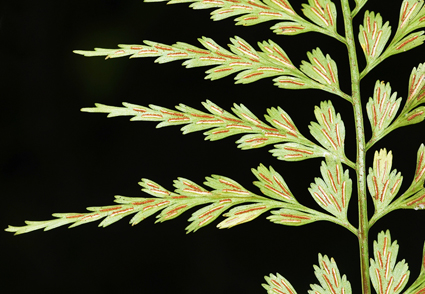Abstract
A new species, Asplenium latipinnulum H. Ding & K.W. Xu, is described from the Wuyishan National Nature Reserve in Fujian, China. Our phylogenetic analyses of six chloroplast loci indicate that this new species is most closely related to A. indicum Sledge, A. planicaule Wall. ex Mett., and A. yoshinagae Makino. They are mainly distributed in eastern and southern Asia. Morphologically, A. latipinnulum is distinguished from A. indicum, A. planicaule, and A. yoshinagae primarily by its 2-pinnate laminae. Additionally, the combination of bright brown rhizome scales, larger fronds with laminae measuring up to 40 cm in length and 18 cm in width, and dark brown to black abaxial stipes and rachises further differentiates the new species from superficially similar species within the A. austrochinense subclade.
References
- Chang, Y.F., Li, J., Lu, S.G. & Schneider, H. (2013) Species diversity and reticulate evolution in the Asplenium normale complex (Aspleniaceae) in China and adjacent areas. Taxon 62 (4): 673–687. https://doi.org/10.12705/624.6
- Ching, R.C. (1931) The studies of Chinese ferns–V. Bulletin of the Fan Memorial Institute of Biology 2: 185–223.
- Ching, R.C. & Wang, C.H. (1964) Additional materials for the pteridophytic flora of Hainan. Acta Phytotaxonomica Sinica 9: 345–373.
- Ching, R.C. (1982) New ferns from Jiulung-Shan, S. W. Zhejiang Province. Bulletin of Botanical Research 2 (2): 61–79.
- Dyer, R.J., Savolainen, V. & Schneider, H. (2012) Apomixis and reticulate evolution in the Asplenium monanthes fern complex. Annals of Botany 110: 1515–1529. https://doi.org/10.1093/aob/mcs202
- Hall, T.A. (1999) BioEdit: a user-friendly biological sequence alignment editor and analysis program for Windows 95/98/NT. Nucleic Acids Symposium Series 41: 95–98.
- Hance, H.F. (1866) Adversaria in stirpes criticas. Annales des Sciences Naturelles; Botanique, sér. 5 5: 256–257.
- Herrero, A., Pajarón, S. & Prada, C. (2001) Isozyme variation and genetic relationships among taxa in the Asplenium obovatum group (Aspleniaceae, Pteridophyta). American Journal of Botany 88: 2040–2050. https://doi.org/10.2307/3558430
- Huelsenbeck, J.P. & Ronquist, F. (2001) MRBAYES: Bayesian inference of phylogenetic trees. Bioinformatics 17: 754–755. https://doi.org/10.1093/bioinformatics/17.8.754
- Katoh, K. & Standley, D.M. (2013) MAFFT multiple sequence alignment software version 7: improvements in performance and usability. Molecular Biology and Evolution 30: 772–780. https://doi.org/10.1093/molbev/mst010
- Landzert, T. (1859) Der sattelwikel und sein verhaltniss zur pro- und orthognathie. Abhandlungen herausgegeben von der Senckenbergischen Naturforschenden Gesellschaft 6: 157–158.
- Lin, Y.X. & Viane, R. (2013) Aspleniaceae. In: Wu, Z.-Y., Raven, P.H. & Hong, D.-Y. (Eds.) Flora of China, vols. 2–3. Science Press, Beijing & Missouri Botanical Garden Press, St. Louis, pp. 267–316.
- Linnaeus, C. (1753) Species plantarum. Salvius, Stockholm, 1200 pp.
- Makino, T. (1900) Phanerogamae et Pteridophytae Japonicae Iconibus Illustrata. Keigyosha & Co., Tokyo, 64 pp.
- Mettenius, G.H. & Kuhn, F.A.M. (1870) Ein Journal für die Botanik in ihrem ganzen Umfange. Linnaea 36: 94–95.
- Miller, M.A., Pfeiffer, W. & Schwartz, T. (2010) Creating the CIPRES Science Gateway for inference of large phylogenetic trees. Proceedings of the Gateway Computing Environments Workshop (GCE), 14 November 2010, New Orleans, LA, pp. 1–8. https://doi.org/10.1109/GCE.2010.5676129
- Ohlsen, D.J., Perrie, L.R., Shepherd, L.D., Brownsey, P.J. & Bayly, M.J. (2015) Phylogeny of the fern family Aspleniaceae in Australasia and the south-western Pacific. Australian Systematic Botany 27: 355–371. https://doi.org/10.1071/SB14043
- Perrie, L.R. & Brownsey, P.J. (2005) Insights into the biogeography and polyploid evolution of New Zealand Asplenium from chloroplast DNA sequence data. American Fern Journal 95: 1–21. https://doi.org/10.1640/0002-8444(2005)095[0001:IITBAP]2.0.CO;2
- Stamatakis, A., Hoover, P. & Rougemont, J. (2008) A rapid bootstrap algorithm for the RAxML Web servers. Systematic Biology 57: 758–771. https://doi.org/10.1080/10635150802429642
- Sledge, W.A. (1965) The Ceylon species of Asplenium. Bulletin of the British Museum (Natural History), Botany 3: 264.
- Van den Heede, C.G., Viane, R.L.L. & Chase, M.W. (2003) Phylogenetic analysis of Asplenium subgenus Ceterach (Pteridophyta: Aspleniaceae) based on plastid and nuclear ribosomal ITS DNA sequences. American Journal of Botany 90: 481–495. https://doi.org/10.3732/ajb.90.3.481
- Walliam, S. & Hooker, J. (1854) Icones Plantarum. Longman, London, 937 pp.
- Xu, K.W., Zhang, L., Rothfels, C.J., Smith, A.R., Viane, R., Lorence, D., Wood, K.R., Chen, C.W., Knapp, R., Zhou, L., Lu, N.T., Zhou, X.M., Wei, J.J., Fan, Q., Chen, S.F., Cicuzza, D., Gao, X.F., Liao, W.B. & Zhang, L.B. (2020) A global plastid phylogeny of the fern genus Asplenium (Aspleniaceae). Cladistics 36: 22–71. https://doi.org/10.1111/cla.12384
- Yatabe, Y., Masuyama, S., Darnaedi, D. & Murakami, N. (2001) Molecular systematics of the Asplenium nidus complex from Mt. Halimun National Park, Indonesia: Evidence for reproductive isolation among three sympatric rbcL sequence types. American Journal of Botany 88: 1517–1522. https://doi.org/10.2307/3558459
- Yatabe, Y., Shonohara, W., Matsumoto, S. & Murakami, N. (2009) Patterns of hybrid formation among cryptic species of bird-nest fern, Asplenium nidus complex (Aspleniaceae), in West Malesia. Botanical Journal of the Linnean Society 160: 42–63. https://doi.org/10.1111/j.1095-8339.2009.00964.x
- Yatabe, Y. & Murakami, N. (2003) Recognition of cryptic species in the Asplenium nidus complex using molecular data—a progress report. Telopea 10: 487–496. https://doi.org/10.7751/telopea20035625


